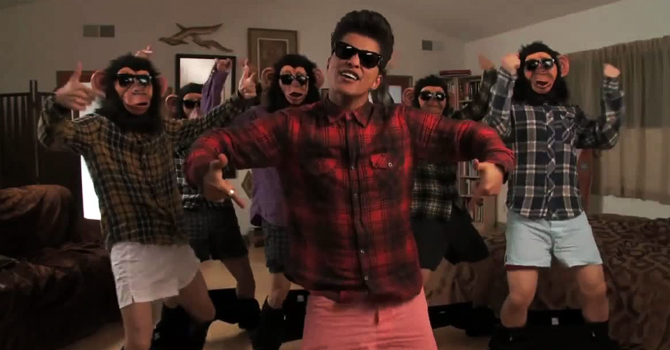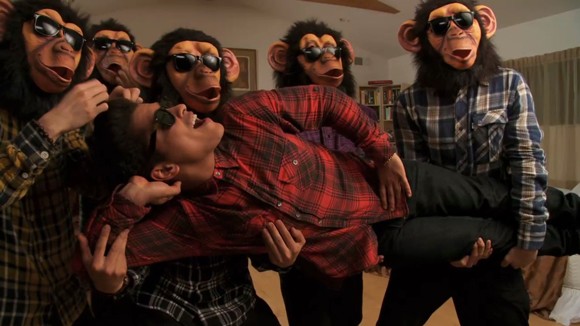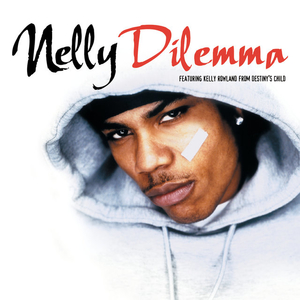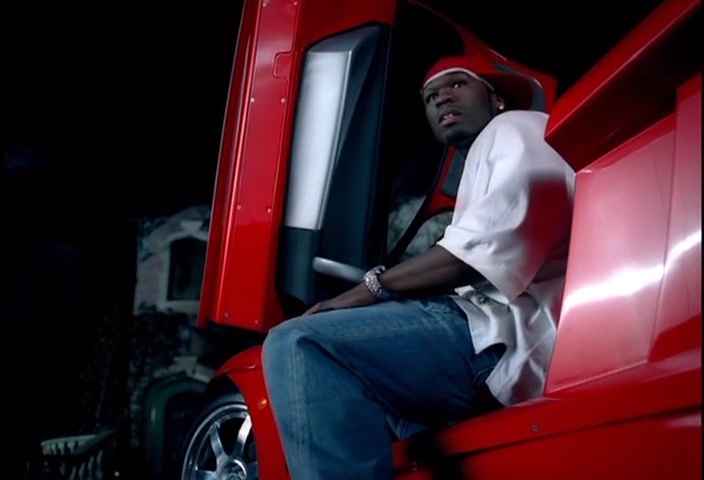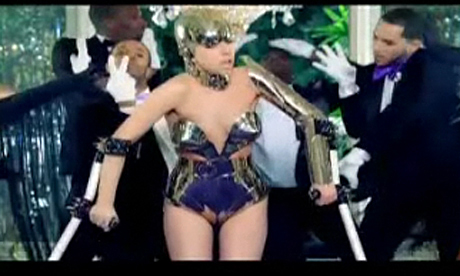Artist - Destiny's Child
Year - 2000
Genre - R&B
Type - Performance/Narrative
Audience - Teenagers
Director -
Say My Name" is a song by American R&B group Destiny's Child. The song was the third single from the group's 1999 album The Writing's on the Wall, released through Columbia label in 2000 (see 2000 in music). The single is the most successful of the four releases from the album and is considered to be one of their signature songs. The song won awards for "Best R&B Performance by a Duo or Group with Vocals" and "Best R&B Song" and two was nominated for "Record of the Year" and "Song of the Year" at the 2001 Grammy Awards and an MTV Video Music Award. - Wikipeadia
The video for " Say My Name" focuses on the lead singer Beyonce Knowles calling her boyfriend up, and suspects him of cheating. She proceeds to ask him to " say her name" but the man hesitates. The narraitve is that he doesnt want the girl who he is cheating on her with to know the name of his current girlfriend on the phone.
Beyonce takes the lead vocals for the song, whilst Kelly Rowland sings the background parts of " love you" " shady" " baby".
In the video all of the different memers of the group are in different rooms with different coloured walls,the camera pans around to reveal the different rooms, the rooms were designed to look like living rooms in the apartment.
We see Beyonce in an orange room, eqaully dressed in orange to match the room, Kelly in a blue room, Michelle in a white room, and the newcomer who was Farrah in a red room.
After the first verse takes place all the girls switch rooms, but keeping the clothes and couches the same colour to the previous room, showing continuity to the video, again a pan shot shows the girls in different room, close ups are used when Beyonce sings, to show more emotion and attitude. There are quick cuts at the beginning of the song, to go with the pace of the music in the introduction, of the different girls.
Then after the second verse during " break down" near the end of the song, the members, all gather in a garage like room complete with cars, to add more to the garage effect.
Destiny's child are now dressed in tight leather pants, skin tight adding to the sexy factor, making more sex appeal, in orange tops. This shows Beyonce as the leader during this video, with them copying her orange from the beginning.
Welcome to my A2 blog, this will feature Research, Planning and Progress towards my final edit of N'sync Gone Music Vid and the 2 ancillary texts. The blog will also feature our Evaluation of our final piece. Feel free to leave criticism :)
Wednesday 14 September 2011
David Guetta - Where Them Girls At
Artists - David Guetta, Nicki Minaj & Flo Rida
Year - 2011
Genre - Electro House/ Hip Hop
Producer - Sandy Vee & David Guetta
Type - Performance/Narrative
Audience - Teenagers
"Where Them Girls At" was released on May 2nd 2011, it is a song by French DJ David Guetta, featuring vocals from Nicki Minaj & Flo Rida. It is the lead single from Guetta's album Nothing But The Beat.
Initially, "Where Them Girls At" was recorded in 2010 and featured just Flo Rida, however after getting into touch with Minaj about a collaboration, Guetta played Minaj the record and she decided to record vocals for it. Computer hackers obtained an a cappella version of the song and added their own production before leaking the song online. - Wikipeadia
The music video was filmed in LA in May 2011 and released in June. In the UK Charts " Where them girls at" debuted at number 3 giving Guetta his 12th top twenty hit.
The beginning of the video we here what appears to be a radio in the background, we then see a pan shot of giant bubbles drifting across the streets of LA, with the music notes clearly seen in them, the camera switches between close ups and leads into an establishing shots. When people burst the bubbles they begin to dance uncontroably to the beat.
The camera cuts between scenes of LA and then stops at what appears to be a hotel poolside, where the camera then pans along groups of girls in bikinis presumably sun bathing, signyfying the sunny weather or climate, whilst also showing the girls as sex symbols, as we see Flo Rida walking through being the only man checking the girls out.
At 0:55 seconds Flo Rida being to rap his part of the song, with the camera now focusing on Flo Rida, stood against the wall, with his " crew" of male friends checking the girls out that walk past. The camera keeps cutting to scenes of the girls in bikinis dancing uncontroably to the beat of the song, then cuts back to Flo Rida.
During the chorus there are alot of point of view shots, long shots, and close ups used, an example of a close up used is at 1:22 on the phone, maybe advertising a phone for sony erricson. There are also pan shots of the LA streets.
The scene then cuts to Nicki Manaj's when she sings her verse, in an art gallery with male models surrounding her. The dancers beind dance almost robotic to the beat of the song, with Niki Manaj in the center it can represent dominance of her. Smaller bubbles are seen coming from her mouth, representing music notes.
David Guetta is then seen 2:24 on the roof top with again girls surrounding him like Flo Rida, turning tables, and creating bubbles. The bubbles that Guetta produces to the music for the video, attract people to his " party" on the roof especially girls.
Year - 2011
Genre - Electro House/ Hip Hop
Producer - Sandy Vee & David Guetta
Type - Performance/Narrative
Audience - Teenagers
"Where Them Girls At" was released on May 2nd 2011, it is a song by French DJ David Guetta, featuring vocals from Nicki Minaj & Flo Rida. It is the lead single from Guetta's album Nothing But The Beat.
Initially, "Where Them Girls At" was recorded in 2010 and featured just Flo Rida, however after getting into touch with Minaj about a collaboration, Guetta played Minaj the record and she decided to record vocals for it. Computer hackers obtained an a cappella version of the song and added their own production before leaking the song online. - Wikipeadia
The music video was filmed in LA in May 2011 and released in June. In the UK Charts " Where them girls at" debuted at number 3 giving Guetta his 12th top twenty hit.
The beginning of the video we here what appears to be a radio in the background, we then see a pan shot of giant bubbles drifting across the streets of LA, with the music notes clearly seen in them, the camera switches between close ups and leads into an establishing shots. When people burst the bubbles they begin to dance uncontroably to the beat.
The camera cuts between scenes of LA and then stops at what appears to be a hotel poolside, where the camera then pans along groups of girls in bikinis presumably sun bathing, signyfying the sunny weather or climate, whilst also showing the girls as sex symbols, as we see Flo Rida walking through being the only man checking the girls out.
At 0:55 seconds Flo Rida being to rap his part of the song, with the camera now focusing on Flo Rida, stood against the wall, with his " crew" of male friends checking the girls out that walk past. The camera keeps cutting to scenes of the girls in bikinis dancing uncontroably to the beat of the song, then cuts back to Flo Rida.
During the chorus there are alot of point of view shots, long shots, and close ups used, an example of a close up used is at 1:22 on the phone, maybe advertising a phone for sony erricson. There are also pan shots of the LA streets.
The scene then cuts to Nicki Manaj's when she sings her verse, in an art gallery with male models surrounding her. The dancers beind dance almost robotic to the beat of the song, with Niki Manaj in the center it can represent dominance of her. Smaller bubbles are seen coming from her mouth, representing music notes.
David Guetta is then seen 2:24 on the roof top with again girls surrounding him like Flo Rida, turning tables, and creating bubbles. The bubbles that Guetta produces to the music for the video, attract people to his " party" on the roof especially girls.
Bruno Mars - The Lazy Song
Year - 2011
Type - Performance/Narrative
Audience - Teenagers, mainly girls Genre - Reggae, Jawaiian & R&B/Pop
Producer- The Smeezingtons
The Lazy Song was written and performed by American singer/song writer Bruno Mars. It was released as his third single from his debut album Doo-Wops & Hooligans on February 15th 2011. The song went on become number 1 in the UK, this made Bruno have his fourth number one in the United Kingdom.
The music video features men, dressed a chipmunks, with the masks to disguise their faces. The whole video is basically one continuous shot, which holds similarities to Green Days video Redundant with it being just one continuous and uninterupted shot. The shots focus on Bruno singing in a bedroom and a living room. We then see the people who are diguised as chimps dancing, messing around, mimicking the lyrics to the song.
The opening shot is of Bruno's face covered by his hands, which cover the rest of the screen,we then see the hands shuffling around the camera, before the lense and camera move out,to reveal 5 men dressed up as chimps, surrounding him. Everyone in the shot are wearing the same, clothes but different clours and same glasses.
At 0.07 seconds the music begins, we then see a medium shot of Bruno and the chimps dancing around nodding the head to the song. The use of monkeys is to attract a child and teenage audience appealing to both boys and girls and is origional as it hasnt been done before.Unlike most music videos there isnt fast paced editing. Instead of the camera moving around the people, the people are moving around the camera, signifying the home video effect.
The mise-en-scene in the room signifies a edroom with a bed, sofa and we can denote from the guitar and skateboard it is supposed to be a boys room played by Bruno in the video singing about how 'today I dont feel like doing anything' which is something that is associated with teens for their laziness, but also with everyone on some days.
The video was originally directed by Bruno Mars himself, and Cameron Duddy.
Bruno Mars - The Lazy Song [Official Video] from Cameron Duddy on Vimeo.
Tuesday 13 September 2011
Kelly Rowland & Nelly - Dilemma
Artist - Nelly & Kelly Rowland
Year - 2002
Type - Narrative/Performance
Genre - R&B/Hiphop
Audience - Mainly Teenagers
Dilemma was a duet between American rapper Nelly and Ex Destiny's Child member Kelly Rowland. The single was released in 2002 from both Nelly's album Nellyville and Kelly's Album Simply Deep. The song won a Grammy Award for the best Rap/Sung Collaboration. Dilemma was Kelly Rowland's first international single since leaving the band Destiny's Child.
The lyrics are based around a love story between two people which just cannot happen. With Kelly being the lead female, and Nelly being the lead male, the video shows the narrative of the lyrics.
The video begins with an slow pan downwards, with a close up on the trees, almost like the beginning of the movie with the title " Welcome to Nellyville" appearing as the camera pans for an establishing shot. We see a long shot of your typical American street, with people mainly kids walking, and riding their bikes, with the camera to the back of them.
Rapping then begins, as we see older big looking black men playing cards, and quick flashes of different people doing different things.
 The rapping then stops and the slower music kicks in when Kelly Rowland begins to sing at (0:24) we see a transition into a long shot of Nelly sat on the step of a house, wearing a hat, sun glasses ( clearing showing the nice weather ) a baggy top and baggy trousers, and trainers, also the words Nelly appear on the screen, presenting him to the audience.
The rapping then stops and the slower music kicks in when Kelly Rowland begins to sing at (0:24) we see a transition into a long shot of Nelly sat on the step of a house, wearing a hat, sun glasses ( clearing showing the nice weather ) a baggy top and baggy trousers, and trainers, also the words Nelly appear on the screen, presenting him to the audience.
The camera then cuts to Kelly also sat on the step looking more stylish with skinny jeans on, boots and a strappy quite low cut top. The title of the song then appears, again making it more like a movie, introducing the singers, and the title of the song.
The camera focuses on each singer when they begin to sing, showing more emotion with the song, and making it add more narrative rather than performance. Kelly is still showing the sex symbol of women, with her short dress (1:33). There are a lot eye line matches and shot reverse shot used to show more emotion of the two, with the song being about love.
The wealth is shown in this video, with the gold chains " bling" and the big houses, the fast cars, all of this misc en scene signifies wealth.
At 3:07 when Kelly is singing and looking out of the window, with Nelly at the bottom you could see some intertextuality being used there, as it is almost like a kind of Romeo and Juliet moment that forbidden or frowned upon love. In this scene is also a low angle shot , long shot on Nelly. The camera then cuts to them in the street and back to Kelly in the window with a medium close up used. The video ends with them dancing in the street close together, with the women who is Kelly's mother telling her to come inside, the words " the end" then appear with a slow fade out to black.
The music video was filmed where Desperate Housewives is filmed now, which is part of Universal Studios. The video premièred on MTV making the video.
Year - 2002
Type - Narrative/Performance
Genre - R&B/Hiphop
Audience - Mainly Teenagers
Dilemma was a duet between American rapper Nelly and Ex Destiny's Child member Kelly Rowland. The single was released in 2002 from both Nelly's album Nellyville and Kelly's Album Simply Deep. The song won a Grammy Award for the best Rap/Sung Collaboration. Dilemma was Kelly Rowland's first international single since leaving the band Destiny's Child.
The lyrics are based around a love story between two people which just cannot happen. With Kelly being the lead female, and Nelly being the lead male, the video shows the narrative of the lyrics.
The video begins with an slow pan downwards, with a close up on the trees, almost like the beginning of the movie with the title " Welcome to Nellyville" appearing as the camera pans for an establishing shot. We see a long shot of your typical American street, with people mainly kids walking, and riding their bikes, with the camera to the back of them.
Rapping then begins, as we see older big looking black men playing cards, and quick flashes of different people doing different things.
 The rapping then stops and the slower music kicks in when Kelly Rowland begins to sing at (0:24) we see a transition into a long shot of Nelly sat on the step of a house, wearing a hat, sun glasses ( clearing showing the nice weather ) a baggy top and baggy trousers, and trainers, also the words Nelly appear on the screen, presenting him to the audience.
The rapping then stops and the slower music kicks in when Kelly Rowland begins to sing at (0:24) we see a transition into a long shot of Nelly sat on the step of a house, wearing a hat, sun glasses ( clearing showing the nice weather ) a baggy top and baggy trousers, and trainers, also the words Nelly appear on the screen, presenting him to the audience. The camera then cuts to Kelly also sat on the step looking more stylish with skinny jeans on, boots and a strappy quite low cut top. The title of the song then appears, again making it more like a movie, introducing the singers, and the title of the song.
The camera focuses on each singer when they begin to sing, showing more emotion with the song, and making it add more narrative rather than performance. Kelly is still showing the sex symbol of women, with her short dress (1:33). There are a lot eye line matches and shot reverse shot used to show more emotion of the two, with the song being about love.
The wealth is shown in this video, with the gold chains " bling" and the big houses, the fast cars, all of this misc en scene signifies wealth.
At 3:07 when Kelly is singing and looking out of the window, with Nelly at the bottom you could see some intertextuality being used there, as it is almost like a kind of Romeo and Juliet moment that forbidden or frowned upon love. In this scene is also a low angle shot , long shot on Nelly. The camera then cuts to them in the street and back to Kelly in the window with a medium close up used. The video ends with them dancing in the street close together, with the women who is Kelly's mother telling her to come inside, the words " the end" then appear with a slow fade out to black.
The music video was filmed where Desperate Housewives is filmed now, which is part of Universal Studios. The video premièred on MTV making the video.
50 Cent - Candy Shop
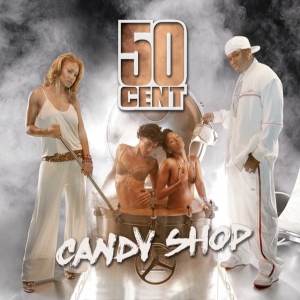 Artist - 50 Cent
Artist - 50 Cent Year - 2005
Genre - Hip Hop
Type - Performance
Audience - Teenagers - Male and Female
Producer - Jessy Terrero
50 Cent AKA Curtis Jackson, released Candy Shop in January 2005. It was released as his second single from his second album The Massacre. It features the female vocals for the chorus of Olivia, and was written by 50 Cent himself.
"Candy Shop" peaked at number one on the Billboard Hot 100, becoming 50 Cent's third number one single. It received mixed reviews from critics, with some calling it a retread of 50 Cent's collaboration with Lil' Kim on "Magic Stick" (2003). At the 2006 Grammy Awards, it was nominated for Best Rap Song, and at the 2005 MTV Video Music Awards, the music video was nominated for Best Male Video. - WikipediaThe video begins with an establishing and pan shot of what appears to be a mysterious mansion, with the element and special effect of smoke to add to the mystery. The camera then stops with a close up on the gates where is states " Candy Shop Lane" automatically linking the video with the song title.
The gates then open and we see a red, sports car driving into the grounds, which to us is your typical stereotype of rich black rappers, and their sports cars. When the car pulls up, there is a close up on the door opening, the camera then pans down where we see a close up on one very white trainer, signifying the gender of the driver.
The camera then pans back up where we see a mid shot of 50 Cent, the music still not starting at this point. There is then a point of view shot as the doors to the house open, where we see a women dressed in stockings and very revealing underwear, with high heels on.
The camera then pans to 50 Cent, at (0:29) the music begins, we then have a close up on the women saying " Welcome to the Candy Shop" looking very provocative and sexual, also her voice is made to sound sexy and appealing.
The beat then kicks in, the camera cuts to 50 Cent sat on his car, dressed like a " Gangster " the stereotypical image of an american black rapper, sat on his sports car.
The camera cuts between the house full of half naked women, whilst 50 is walking past them checking them out, and 50 sat on his car when the rapping bits appear in the song.
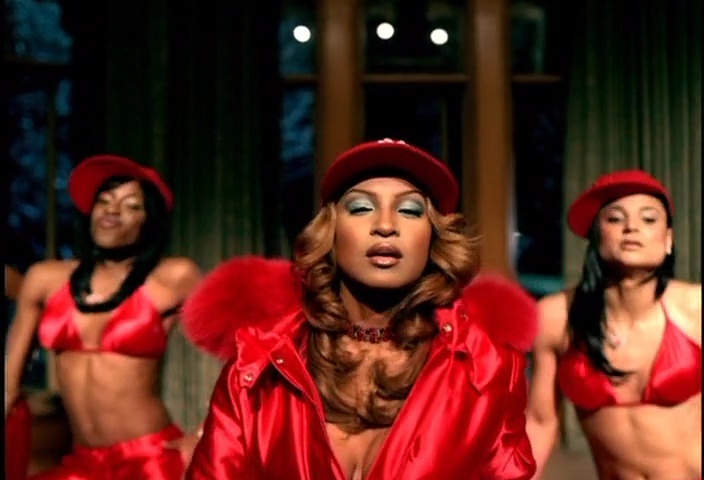 We then here a women Oliver repeat exactly what 50 said but in a more sexy manner, whilst dancing against the wall, still in her sexy outfit.
We then here a women Oliver repeat exactly what 50 said but in a more sexy manner, whilst dancing against the wall, still in her sexy outfit. At 1:08 we see 50 Cent on a bed with some women again dressed in hardly anything, dancing for him and " grinding" on him, immediately signifying sexual natures, the video adds a different meaning to the song title. " Candy Shop" doesn't really seem that sexy, it seems more childlike, where as the video and the lyrics show another aspect.
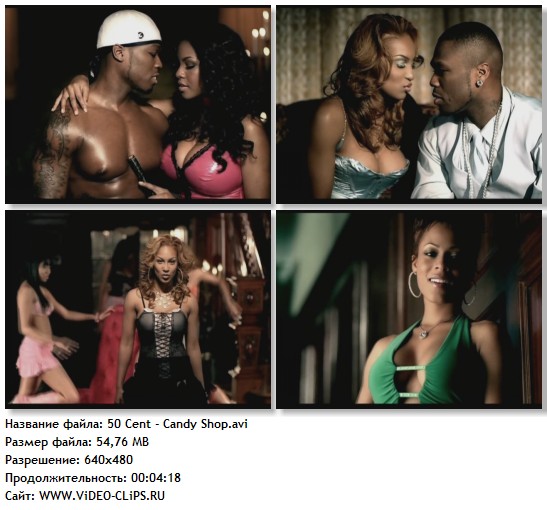 The video basically has all the elements of a rappers video, the half dressed girls, the sexy dancing, the explicit language, the outfits worn.
The video basically has all the elements of a rappers video, the half dressed girls, the sexy dancing, the explicit language, the outfits worn. It shows women as the sex symbols they are mostly seen as, however in some parts shows them having more control over then man even if it is sexually. Which in some ways changes the stereotypical aspect of women being weak. However in this video women are seen as the objects of males affection.
Some of the lyrics could be seen as offensive towards women, the way 50 talks about them and their sexual ways.
50 Cent received mixed reviews for this video :
The song received mixed reviews from critics. Pop Matters described it as "dripping with sexual energy and cool" and is "sexy as hell, but contains a pretty unmistakable edge of hostility, macho swagger, and thunderous chest thumping."[10] - Wikipedia ( Positive Response )
Entertainment Weekly wrote that it was an "appealing throwaway single" and lyrics such as "after you work up a sweat, you can play with the stick" are not seductions; "they're orders" - Wikipedia ( Negative Response )
Beyonce - Best Thing I Never Had
 Artist - Beyonce Knowles
Artist - Beyonce Knowles Year - 2011
Genre - R&B/Pop
Producer - Baby-face ( couldn't find director)
Audience - Teens, mainly female
Type - Performance/Narrative
" The Best Thing I Never Had" was written and performed by the American singer ex Destiny's child Beyonce Knowles. On June 1st Columbine Records released Beyonce's second single for her album 4.
The powerful lyrics in the song, relate to themes of revenge and karma. The main theme of the song is the female not wanting to end up heartbroken, so she relates how she is happy to have parted from her former partner, who refused to live a happy life with her, and give her everything she wanted like a boyfriend/husband should. Some critics stated that the theme of "The Best Thing I Never Had" is very much like her song Irreplaceable . The single peaked at number 2 in the UK Single Charts, and number 3 in the US R&B/Hip Hop songs chart.
 The video begins with a fade in mid-shot of Beyonce in white sexy lingere, in a white painted room, with what appears to be a white bunch of flowers behind her. She is stroking the material in front of her whilst singing the line "What goes around comes back around, my baby" whilst looking up and down, the stroking of the material could link with the baby bit, being patronising stroking things as if it was the man she is talking about.
The video begins with a fade in mid-shot of Beyonce in white sexy lingere, in a white painted room, with what appears to be a white bunch of flowers behind her. She is stroking the material in front of her whilst singing the line "What goes around comes back around, my baby" whilst looking up and down, the stroking of the material could link with the baby bit, being patronising stroking things as if it was the man she is talking about. The music begins straight away, and then a close up of Beyonce is used on her face looking towards the camera, there is then a close up of her holding a white rose, presumably one from the big bunch in the room, presumably given to her by a man.
There is then a pan to the mirror, where a long shot is then used to show Beyonce walking towards the mirror. The camera then cuts back to a mid-shot when she is stood in front of the chairs. The hair style worn by Beyonce at the beginning is almost quite similar to princess leia in Star Wars, so here we can see some form of intertextuality.
We then see the camera cut to Beyonce lying on a bed during the chorus ( 1:00) , still wearing her underwear however this time wearing a veil, signifying a wedding, and that she is the bride. A high angle shot is used to show her rolling round on the bed, focusing more on her, this could represent more of the power in herself now, we then see an extreme close up on her face, showing emotion and expression.
The camera then cuts to a different setting of a field, with Beyonce wearing a white dress and a veil. The camera then flashes to what appears to be video recording of a flashback, we can clearly see that this is a prom from the misc en scene, and clothing worn. The date in the corner of the video camera can denote the year it was, May 1998, the camera then cuts back to the present Beyonce where we see an establishing shot of the lake and sunset background when Beyonce is running down the hill.
 We then get another mid shot of Beyonce sat lip-syncing in the sun, then we see a close up of her trail from the dress. The camera then pans back up to Beyonce's head. Near the end of the video we see cuts between shots of Beyonce in the field and her walking down the aisle.
We then get another mid shot of Beyonce sat lip-syncing in the sun, then we see a close up of her trail from the dress. The camera then pans back up to Beyonce's head. Near the end of the video we see cuts between shots of Beyonce in the field and her walking down the aisle. There is an element of mystery and narrative enigma as we as an audience are lead to believe that the man from the video earlier, is the man she is marrying. However the very last scene we see this is not the case, and the video ends with a close up on Beyonce's face happily smiling.
Man Down - Rihanna
 Artist - Rihanna
Artist - RihannaYear - 2011
Director - Anthony Mandler
Audience - Teenagers
Type - Performance/Narrative
Genre - Reggae
Man Down" is a song performed by Barbadian recording artist Rihanna, taken from her fifth studio album Loud (2010). "Man Down" received positive reviews from music critics, with many calling it a comeback of Rihanna's Caribbean-tinged rhythm.- (Wikipedia)
The video for Man Down focuses on Rihanna having shot a man, and later on regretting her actions. The video had some kind of violent nature to it, so due to this The Parent Television Council fought to have the video banned, however failed with no success. The music video for Man Down was shot in Jamaica in April 2011. Here is a quote from the director of Man Down, taken from Wikipedia
"We shot the video last month in Jamaica and it's my favourite song she's ever recorded, so I was really excited to get involved. And it's just one of those songs that demands a strong narrative and visual, and let's just say she let me go all the way. So I think you can expect something that's dramatic and shocking and intense and emotional and uplifting and enlightening".
The video begins and we see a crowd of Jamaican people walking around what looks like a village, the setting is immediately set in the first scene. We then see Rihanna slowly walking out of what seems to be a path way, walking through the darkness, the camera is revealing her slowly whilst cutting back to the village in between. We then at 28 seconds in see a flash of a gun, the crowd starts walking around, no music has started at this point, then suddenly we see a man being shot from behind, we then see a close up on a red head, with smoke coming from her which appears to be Rihanna. Whilst the camera is then focusing on the shot man, Rihanna is seen running away from the scene.
The flashback could be used to help create a timeline of events leading up to the shooting to help the audience understand why the shooting took place.
A clip in between is also shown of Rihanna sitting in a low lighted room maybe showing the time of day on the edge of her bed, looking sad, the camera then cuts back to her walking through the town.
At 1:13 the camera cuts back to the bedroom where we see Rihanna beginning to sing, with flashes of her laughing and joking in the village, this could signify that the Rihanna sat in the bedroom is remembering what happened and regretting what she did by saying " I didn't mean to end his life" at 1:14. Even though the lyrics and meaning to this song are pretty dark, Rihanna still manages to keep that sexy look that she creates by wearing short tops, low cut dresses clearly highlighting her breasts, and also the flirtatious looks she gives the man in a flashback.
The camera then cuts to a scene of Rihanna entering a nightclub, at 2:54, then begins to dance, red lights for special effects of the nightclub are used during this scene, which could signify blood or danger, again leading up to the events shown at the very beginning of the video. Rihanna then begins to flirt with another person in the club, who turns out to be the man she shot in the beginning.
Rihanna sex appeal is still again clearly highlighted especially in this scene of the club, as you can see at 3.35 onwards she is seen flirting in very skimpy clothes whilst dancing and grinding on the man ,keeping " the Rihanna look" but also at the same time showing the "Male Gaze" theory of how women are seen and treated, this video for me highlights this very good. The quick flashes used during this scene highlights the pace and tension of music getting faster and also maybe the danger in the video building up to the shooting.
 The camera then shows Rihanna walking out of the club and the man she was dancing with following her out, looking for her, the man then begins to get violent. In between this scene the camera keeps cutting to her in a boat in what appears to be a waterfall river, this to some audience could signify her happy place, a more tranquil place to ease on the violence.
The camera then shows Rihanna walking out of the club and the man she was dancing with following her out, looking for her, the man then begins to get violent. In between this scene the camera keeps cutting to her in a boat in what appears to be a waterfall river, this to some audience could signify her happy place, a more tranquil place to ease on the violence. The music then stops at 5:09 and we see Rihanna crying in a street and then running down a road after what appears to have been a sexual assault, clearly hurt and scared, towards a draw where she pulls the gun from, there is a close up used to highlight Rihanna's face and the gun, signifying the conclusion of the video is clearly the beginning where she shoots the man.
 Rihanna received a lot of controversy and complaints for this video, due the murder scene, and what appears to be sexual assault scene. Parents were worried that this video would be showing young girls it is right to kill someone who has raped or sexually abused you.
Rihanna received a lot of controversy and complaints for this video, due the murder scene, and what appears to be sexual assault scene. Parents were worried that this video would be showing young girls it is right to kill someone who has raped or sexually abused you. However Rihanna replied by saying
"I'm a 23 year old singer who doesn't have kids. What's up with everybody wanting me to be a parent [to their children]? I'm just a girl, I can only be our voice. We all know it's difficult and embarrassing to communicate touchy subject matters to anyone, especially our parents. The music industry isn't "Parent's 'R Us." We have the freedom to make art; let us! It's your job to make sure your children don't turn out like us. You can't hide your kids from society, or they'll never learn how to adapt. This is the real world!" - Wikipedia
Celine Dion - My Heart Will Go On
Year - 1997
Genre - Pop/Soft Rock
Producer - Walter Afanasieff
Director - Billie Woodruff
Audience - Adults/Teenagers of the time
Type - Performance/Narrative
"My heart will go on" was composed originally as a backing track for certain scenes in the movie Titanic, starring Leonardo Decapprio. During the making of the film, James Horner who composed the music, wanted to develop a lyric version of the ballad for the end credits.
"My Heart Will Go On" is the theme song/love theme of the 1997 blockbuster film Titanic. With music by James Horner, lyrics by Will Jennings, and production by Walter Afanasieff, it was recorded by Céline Dion.[1] Originally released in 1997 on Dion's album Let's Talk About Love, it went to number 1 all over the world, including the United States, United Kingdom and Australia. ( Wikipedia )
Will Jennings then went on to write the lyrics, for "My Heart Will Go On" .
 The beginning of the video as you can see from the picture to the right, begins with the sound of the song but no singing, we do not see Celine Dion in the video until 20 seconds into the video, the beginning is mainly a montage of slow flashes of the movie highlighting the main characters with the soundtrack in the background. Celine Dion begins singing the first verse 20 seconds in as you can see from the picture there is a close up on Celine Dion's face on a black background, At 49 seconds the background behind Celine Dion changes to a orange colour almost the colour of the sun setting, this could be to highlight her face more.
The beginning of the video as you can see from the picture to the right, begins with the sound of the song but no singing, we do not see Celine Dion in the video until 20 seconds into the video, the beginning is mainly a montage of slow flashes of the movie highlighting the main characters with the soundtrack in the background. Celine Dion begins singing the first verse 20 seconds in as you can see from the picture there is a close up on Celine Dion's face on a black background, At 49 seconds the background behind Celine Dion changes to a orange colour almost the colour of the sun setting, this could be to highlight her face more. At 1:17 we see Celine Dion on the boat presumably a replica of the Titanic boat from the film, linking her to the film Titanic more, this is good with it being a theme song.
Most of the video contains transitions between scenes of the film, with Celine Dion in the corner, dressed in white so she stands out as well as the scenes, still promoting Celine Dion, I think this will mainly be because the song was the theme tune for the film, the video in some ways could of also been a way to advertise the film even more.
 There are a lot of pan shots,gradual close ups, long shots and over the shoulder shots used during the video especially between 2:54 and 3.12 during showing the icon part of the film, just before the music picks up its pace. Whilst the music is slow, the shots and clips are slow to go with the pace of the music, also have more happy scenes of the film are shown.
There are a lot of pan shots,gradual close ups, long shots and over the shoulder shots used during the video especially between 2:54 and 3.12 during showing the icon part of the film, just before the music picks up its pace. Whilst the music is slow, the shots and clips are slow to go with the pace of the music, also have more happy scenes of the film are shown. When the music picks up pace at 3:15 the video begins to show more dramatic scenes from the film, where the boat beings to crash, the darkness, the tension build. This part of the song highlights Celine's strong vocals, whilst a zoom out makes her stand out more revealing the white dress against a black background. Near the end of the video the last strong note is held by using a echo of Celine Dion's voice prolonging the note.
Monday 12 September 2011
Rihanna - Umbrella
 Artist - Rihanna
Artist - Rihanna Year - 2007
Genre - R&B
Producer - The Dream & Tricky Stewart
Type - Performance
Audience - Teenagers
"Umbrella" is a song recorded by Barbadian singer Rihanna, featuring a rap verse by Jay-Z. The song was written by The-Dream, Christopher Stewart, Kuk Harrell and Jay-Z, and was produced by Stewart and The-Dream for Rihanna's third studio album, Good Girl Gone Bad (2007). "Umbrella" is a contemporary R&B and hip hop song and lyrically it refers to a romantic and platonic relationship and the strength of that relationship. It is generally considered as Rihanna's signature song. - Wikipedia
The song became one of Rihanna's most icon songs, Entertainment weekly ranked the song number one on the 10 best single charts, Rolling Stones also listed Umbrella at number 3 in the 100 best songs of 2007. In the year of its release 2007, Umbrella was nominated for 4 awards in the MTV awards, and won 2. Rihanna and Jay Z also won an award at the Grammy's for Umbrella being the best rap/song collaboration.
The year and season of release is icon to the name of the song, as the weather for the time of summer when it was released was constant rain, making the song storm through the charts.
The video for Umbrella ties into lyrics, with each scene containing rain in the background, and also the props used such as an umbrella, which is typical of English weather.
 The video begins with rhianna dressed in black, with this sultry look, in almost some kind of seductive position, stating her sex symbol that she is seen as today. Jay Z also starts by saying " Good girl Gone Bad" , this video made her the sex symbol she is today, the black suductive look, is completly different to previous videos such as If Its Loving That You Want
The video begins with rhianna dressed in black, with this sultry look, in almost some kind of seductive position, stating her sex symbol that she is seen as today. Jay Z also starts by saying " Good girl Gone Bad" , this video made her the sex symbol she is today, the black suductive look, is completly different to previous videos such as If Its Loving That You Want which have a more colourful sweet theme, the difference in these videos could tie in with Jay Z comment Good Girl Gone Bad.
The video is still keeping the traditional theme of Male rapper songs, in Jay Z parts with the female dancers, keeping them young and sexy, wearing Mini Shorts, and showing leg with Jay Z in the middle of them, maybe showing the authority of the male.
In the first chorus scene, the Rihanna from the beginning is now dressed in white, showing her purity, as well as having close ups on the " bad rhianna".

The video is fast paced you can see this from the longest scene being 5 seconds long, there are also lots of fast paced straight cuts, and fade ins. Most of the close ups featured on Rihanna are mainly when she is hitting a high note or holding a note for a while.
Special effects such as smoke at the beginning are used to highlight Rihanna body, and dark side to make her look more mysterious. The more special effects used are things like rain on the screen, to create an illusion of rain, (1:15). Laura Macavoy's male gaze theory can also be seen, with the provocative female dancers.
Lady Gaga - Paparazzi
Year - July 5th 2009
Producer - Rob Fusari
Genre - Electropop Type - Narrative/Performance
Paparazzi was wrote by Gaga and Rob Fusari in 2008, and released in 2009 as the final song for her album Fame. The song was released in the format of a CD and digital download. Although being released in July 2009, Gaga's other song " Love Game" was originally going to be the third single released, however due to the lyrics and controversy over the video, Paparazzi was released first.
The accompanying video shows the story and holds the narrative of Lady Gaga playing a young women who has rose to fame, and becomes hounded by photographers, then near the beginning of the video in the first scene Gaga is nearly killed by her boyfriend.
The video won two MTV Video Music Awards in 2009 for Best Art Direction and Best Special Effects. Gaga also performed the song at the 2009 MTV Video Music Awards in a performance art piece symbolizing the negative effect of fame leading to death. - Wikipedia
The main focus of the video is showing Gaga's comeback, strength and revenge upon her boyfriend, it also shows her experience of fame.
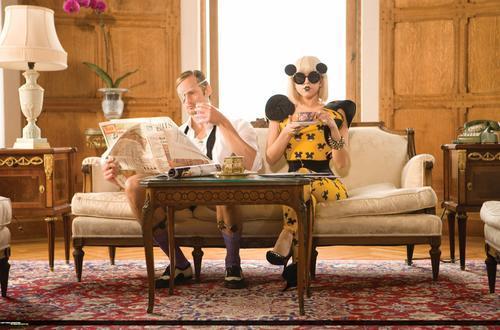 The second scene shows Gaga having survived nearly being killed by her boyfriend, pulling up in a limo, being helped out using these gold crutches in a tight purple costume, with jewelry on, this automatically shows her class status and her fame. As well as having a narrative to the video, Gaga has the performance side with the dancing inbetween scenes.
The second scene shows Gaga having survived nearly being killed by her boyfriend, pulling up in a limo, being helped out using these gold crutches in a tight purple costume, with jewelry on, this automatically shows her class status and her fame. As well as having a narrative to the video, Gaga has the performance side with the dancing inbetween scenes. A lot of bright clothes and colours are used in the video, contrasting with the theme of revenge in the video. The colours could match Gaga's mood.
Madonna's iconic bra is also replicated once again by Lady Gaga in this video during the second scene in her gold and purple suit, almost robotic effect.
Quick cuts, and integrated scenes are used during the video, in order to tell the story, and keep the narrative going.The last scene we see Gaga and her boyfriend, this is the penultimate scene of the video, where we see Gaga poisining her boyfriend and killing him. Gaga has black glasses on and a yellow and black all in one.The outfit could resemble a Bee or Wasps, who can also kill or sting. The killing by using poison can also in some way be stereotyping the weakness of women.
Sunday 11 September 2011
Chase And Status - Time
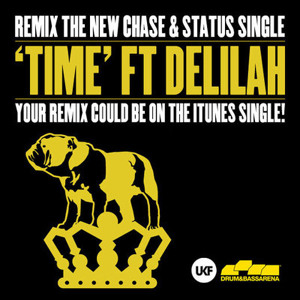 Artist - Chase and Status
Artist - Chase and Status Year - 2011
Director - Lindy Heymann
Genre - Drum and bass
Type - Narrative with aspects of performance
Audience - Mainly teens
"Time" is a single from British drum-and-bass duo Chase & Status that features vocals from British singer Delilah. The single was released in the United Kingdom as a digital download on 29 April 2011[1] and serves as the fifth release from the studio album No More Idols - (Wikipedia Reference 2011)"Time" was first released in the charts on the 27th March 2011 when it debuted at number 40 in the dance charts.
The video begins with a scene of a happy looking family, smiling all around but with the eye of a cautious young girl. The screen then cuts to a bedroom which appears to be the girls, where we see her sitting on her bed looking scared with headphones on, this could signify her wanted to block some form of sound from her.
This video clearly contains scenes of domestic violence, highlighting how some families arnt all they seem, and the difficulty behind domestic violence. The first indication of domestic violence we see is when the camera cuts to a man abusing a women, the same man and women from the beginning.
The video contains lots of flashbacks and cuts between past and present, before and after the domestic violence.
Through out the video " Delilah" is seen in the back seat of a car singing, with the rain and the gloomy sky hovering around the car and the darkness, this setting of the part of the song can help relate to the young girls emotions through out the video.
The video did cause contreversy with it's disturbing images and depressing storyline, but it managed to get aired.
The lyrics are pretty much the same all the way through which is common for drum and bass. The relationship between the visuals and the music is similar, as the music isn't that upbeat and has the same pace all the way through, the video matches the music, showing the tension and the outcome between the family.
Subscribe to:
Posts (Atom)









